Threats to standing balance, such as standing at the edge of a roof or on a ladder are known to evoke fear, anxiety and arousal. Moreover, these height-induced postural threats are known to alter standing balance control. The vestibular system, or inner ear balance organ, is thought to contribute to threat-related balance changes because it is a major contributor to balance control, and because the vestibular nuclei in the brainstem are heavily interconnected with nervous system regions associated with fear, anxiety and arousal. We tested this hypothesis by examining how balance responses to electrically-generated vestibular error signals were affected by exposure to a height-induced postural threat.
Young healthy adults were exposed to two height-induced postural threat conditions; first they stood on a hydraulic lift at a ground-level equivalent condition (LOW), then they were elevated to a 3.2m-high condition (HIGH; Fig 1A). Binaural bipolar stochastic electrical vestibular stimulation (SVS; 2-25Hz) was used to evoke balance responses; balance responses were recorded with a force plate. Participants stood with their head facing either forwards or turned 90° to the right (see Fig 1A) so that vestibular-evoked balance responses were evoked in different directions (perpendicular to head orientation). We anticipated that if postural threat primes the vestibular system for balance control, then evoked balance responses would be larger and better correlated with SVS inputs while standing at height. We characterized the relationship between SVS and balance responses with time-domain correlations (‘cumulant density’); frequency-domain correlations (‘coherence’); and frequency-domain signal gain (amplitude) estimates. Height-induced postural threat led to greater correlation between the signals (larger cumulant density peaks and greater coherence; Fig 1B, C), and larger gains at all frequencies (Fig 1D).

The stronger relationship between vestibular inputs and balance response outputs in the HIGH threat condition suggests that the balance control system responds more faithfully to vestibular inputs at height. These results are similar to threat-related changes observed in other clinical measures of vestibular reflexes, and to other balance-relevant sensory systems, including muscle spindle stretch and Golgi tendon organ-Ib reflexes. We interpret these findings as evidence for context-dependent tuning of sensory-motor interactions, and speculate that this is a normal aspect of human balance control. Furthermore, a failure to adequately control such tuning processes, perhaps by either becoming hyper- or hypo-sensitive to balance-relevant stimuli under threatening or challenging situations, might contribute to poor balance performance in the elderly or in people with anxiety or neurologic balance impairments.
Publication
Horslen, B. C., Dakin, C. J., Inglis, J. T., Blouin, J.-S. and Carpenter, M. G. (2014), Modulation of human vestibular reflexes with increased postural threat. J Physiol, 592: 3671–3685. doi:10.1113/jphysiol.2014.270744
About the Author

Brian Horslen
The University of British Columbia
Brian Horslen is a NSERC-funded PhD candidate under the supervision of Prof Mark Carpenter at The University of British Columbia in Vancouver, Canada. His research focuses on how threats to standing balance influence postural control and balance-relevant sensory function. The research presented here forms part of his doctoral dissertation.
Copyright
© 2018 by the author. Except as otherwise noted, the ISPGR blog, including its text and figures, is licensed under a Creative Commons Attribution-ShareAlike 4.0 International License. To view a copy of this license, visit https://creativecommons.org/licenses/by-sa/4.0/legalcode.
ISPGR blog (ISSN 2561-4703)
Are you interested in writing a blog post for the ISPGR website? If so, please email the ISGPR Secretariat with the following information:
- First and Last Name
- Institution/Affiliation
- Paper you will be referencing
